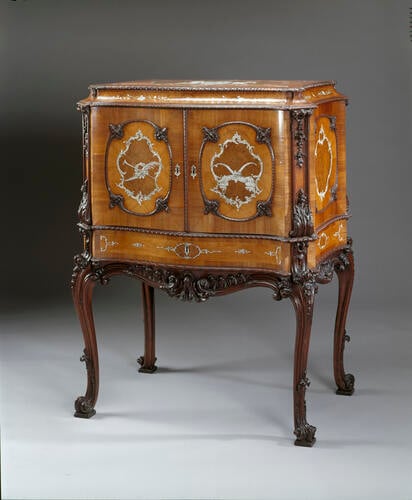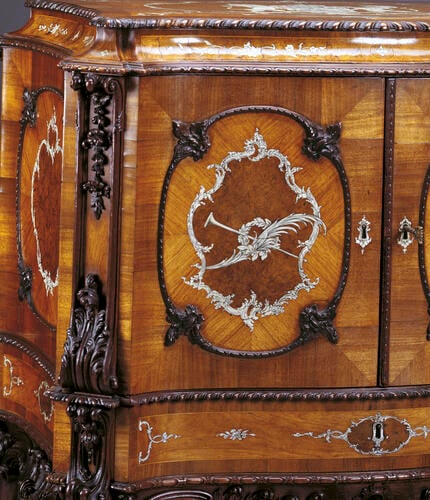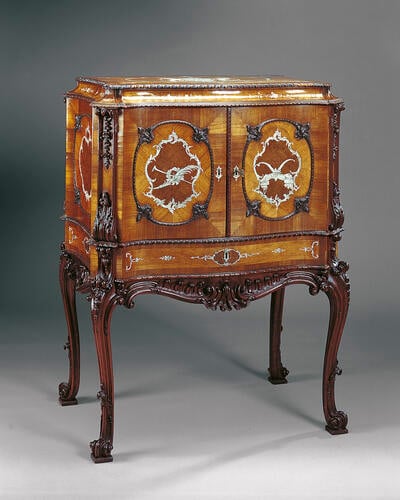-
1 of 253523 objects
Jewel cabinet 1762
Mahogany, amboyna, rosewood, holly, olive, padouk, oak, ivory | 108.0 x 81.3 x 55.9 cm (whole object) | RCIN 35487
-
This sumptuous object, often seen as William Vile’s masterpiece, was the single most costly piece of furniture Vile made for King George III or Queen Charlotte. Placed in the Queen’s private apartments in the south-east angle of St James’s Palace, the jewel cabinet was part of the expensive refurnishing of St James’s undertaken by Vile (with his partner John Cobb) following the King’s marriage in 1761. Two years later, by which time the focus of royal interest had shifted to Buckingham House, the cabinet had been moved to the Queen’s new bedchamber there and Vile then supplied a marbled leather cover for it at a cost of 9s 6d.
Vile’s bill for the cabinet describes it as ‘very handsome . . . made of many different kinds of fine Woods’, and alludes to the most distinctive feature as follows: ‘all the Front, Ends and Top inlaid with Ivory in Compartments and neatly Engraved’. The use of engraved ivory decoration, which includes Queen Charlotte’s coat of arms on the hinged top and trophies emblematic of Fame or Victory and Plenty on the doors, is virtually without parallel in English furniture at this (or any) date, and suggests some familiarity with continental practice - Italian or German - within Vile’s workshop. The tradition of ivory inlay was certainly well established in northern Germany and is seen in the contemporary work of Abraham Roentgen. Roentgen was in England in the 1730s and maintained connections with the German community in London in the following decades.
The ‘fine Locks’, also referred to in Vile’s bill, were supplied by Mrs Elizabeth Gascoigne, a specialist metalsmith used by several leading cabinet-makers at this date, and were constructed with great precision to safeguard the Queen’s magnificent jewellery. These jewels were much remarked on by contemporaries and included pieces inherited by George III from his grandfather George II, as well as the share which the King had bought from his uncle, the Duke of Cumberland. Among the highlights were a diamond stomacher valued at £70,000, two diamond necklaces, drop earrings, rings and flower-sprays as well as a great quantity of large pearls.
Catalogue entry adapted from George III & Queen Charlotte: Patronage, Collecting and Court Taste, London, 2004Provenance
Made for Queen Charlotte (£138 10s.; PRO LC9/308, no.8 qtr to Christmas 1762); her daughter, Princess Mary, Duchess of Gloucester (d.1857); (?) George 2nd Duke of Cambridge, (?) by whom given to his sister, Princess Mary Adelaide, Duchess of Teck (d.1897); by descent to her grandson, George, 2nd Marquess of Cambridge, from whom bought by his aunt, Queen Mary, 1951 (£5,000).
-
Creator(s)
(cabinet maker)(locksmith)(nationality)Acquirer(s)
-
Medium and techniques
Mahogany, amboyna, rosewood, holly, olive, padouk, oak, ivory
Measurements
108.0 x 81.3 x 55.9 cm (whole object)
Category
Object type(s)
Alternative title(s)
Queen Charlotte's Jewel Cabinet



